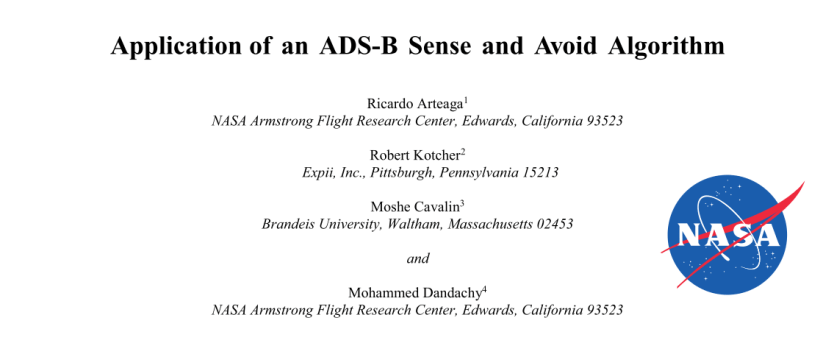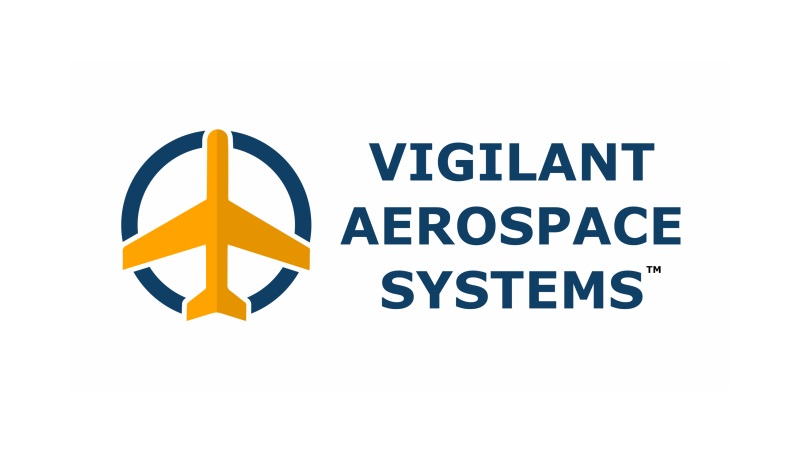Research and Product Testing of NASA ADS-B Detect-and-Avoid Algorithm
Lead by Ricardo Arteaga, CxP Orion Flight Systems Engineer at NASA Dryden, the research team based out of the NASA Armstrong Flight Research Center in Edwards, California recently published a research document titled “Application of an ADS-B Sense and Avoid Algorithm,” discussing the testing of their patented (
Patent #9,405,005) ADS-B, sense and avoid, avionics software.
The software,
exclusively licensed by Vigilant Aerospace Systems, outlined in the document provides the foundation for our
FlightHorizon detect and avoid avionics software for manned and unmanned aircraft systems.
As this research has great implications for the future of sense-and-avoid technology in the national airspace, we’ve shared some highlights from the research document below.
Below is a brief summary with excerpts explaining what this research means for the future of unmanned systems integrations into the national airspace.
Read the full 20-page document:
Application of an ADS-B Sense and Avoid Algorithm_AFRC-E-DAA-TN30918_20160007770 [PDF]
Benefits of ADS-B Integration
Automatic Dependent Surveillance-Broadcast (ADS-B) improves on current radar-based systems by providing more precise tracking and faster transmitting. According to research, “[ADS-B] tracks aircraft position with a much higher resolution and lower error rate [than existing radar-based systems].”
ADS-B can be broken into two categories: ADS-B Out and ADS-B In.
“ADS-B Out refers to the broadcast of ownship state information of an appropriately equipped aircraft. ADS-B In refers to the ability of an appropriately equipped aircraft to receive and display ADS-B information from other aircraft.”
Typically, ADS-B systems rate a navigation accuracy category (NAC
p) ADS-B accuracy parameter of 8 or 9 rather than the standard radar systems which typically rate at a NAC
p of 6 or 7.
Also, ADS-B systems have less physical and mechanical drawbacks allowing for more information to transmit more efficiently: “Without the mechanical constraints of radar-based systems, ADS-B systems can update an aircraft state much faster (typically 1Hz, instead of once every 12 seconds).”
Important Regulatory Notes for Next Generation Air Traffic Control Systems (ATC)
- As of January 2020, the U.S. Federal Aviation Administration (FAA) has mandated that all aircraft operating within the National Airspace System (NAS) class A airspace must be equipped with ADS-B Out technology. See the FAA FAQs page for more information on this regulation.
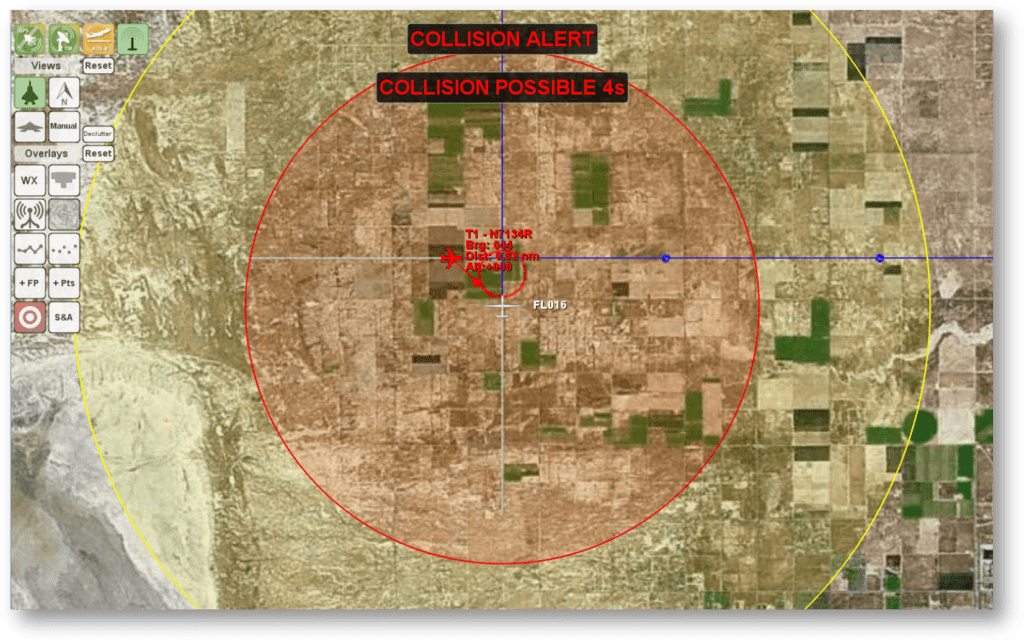 Stratway Algorithm Integrated with ADS-B Sense and Avoid System
Stratway Algorithm Integrated with ADS-B Sense and Avoid System
“ADS-B SAA display integrated with the Stratway algorithm provides the pilot with three general categories of information intended to support: (1) situation awareness, (2) conflict detection, and (3) conflict resolution.”
The image to the right is a screen shot of the ADS-B traffic display showing (a) the conflict detection sphere, (b) intruder and encounter information data, (c) range selection with automatic zoom, (d) the ownship selection for sense and avoid, and (e) the sense and avoid toggle on/off for selected target.
“Target detection is accomplished by the ADS-B transceiver, which can either be airborne or on the ground. The Stratway algorithm is then used for detecting conflicts as well as performing self-separation avoidance maneuvers.”
All resolution advisories (RAs) are both visually represented in the display and provided in vocalized alerts that direct the pilot in maneuvers to increase separation with conflicting aircrafts.
“Stratway is an optimized resolution, and the way in which we present its output to the end user is specific enough to ensure that it is treated as such. Our strategy instructions are accompanied by details including maximum bank angle (limits the bank angle an aircraft can achieve) and maximum rate of climb and descent for the respective maneuvers. This approach helps to ensure the ownship remains conflict-free in scenarios with multiple target aircraft.”
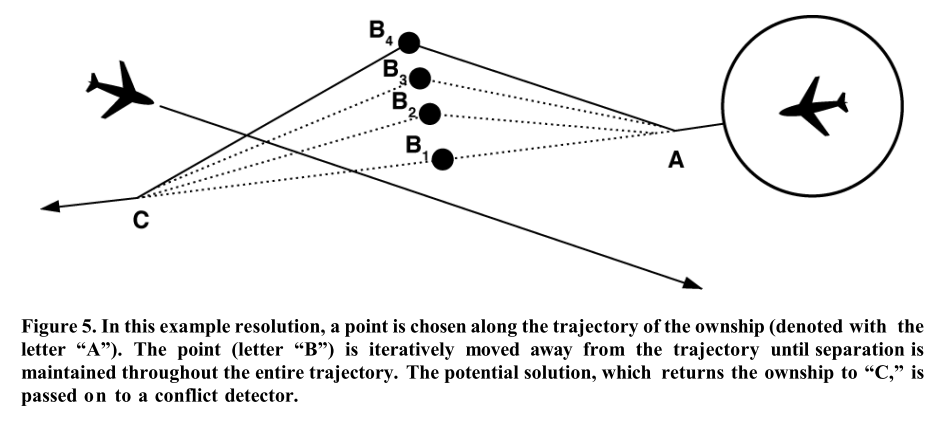
When a conflict is detected, analytical strategies are iterated. Strategy parameters are iterated until a conflict no longer exists. This process is represented below in Figure 5 above, which illustrates a conflict resolution operating on a latitude and longitude of a point. Two initial points are chosen (points A and C) with a diverted point between which is “shifted further from the original flight until the operational limits of the ownship have been reached or separation is maintained.”
Sense and Avoid Sub-Functions of System
From document: Table 2. Sense and avoid sub-functions
| Sub Functions |
Explanation |
| Detect: |
Detect presence of aircraft in vicinity of UAS |
| Track: |
Estimate position and velocity (state) of intruders based on one or more surveillance reports |
| Evaluate: |
Assess collision risk based on intruder and UAS states |
| Prioritize: |
Prioritize intruder tracks based on a collision risk threshold |
| Declare: |
Decide that action is needed |
| Determine: |
Determine what action is required |
| Command: |
Communicate determined action to UAS |
| Execute: |
Execute the determined action |
Sense and Avoid System Pilot Usability
Before conducting a live test of the sense and avoid software, a simulation tool was designed into the software to allow for NASA pilots to test and score the user performance and experience of working with the software. The test was conducted on a range of pilots including a fighter pilot, large transport pilot, general aviation pilot, and unmanned aircraft vehicle pilot.
“Each pilot was asked to fly an encounter scenario, such as the scenario shown in Fig. 7, in this simulated environment after having received minimal instructions on how to use the software. Each encounter scenario had at least one future loss of separation in the horizontal or vertical dimension. At the onset of the simulation, the two aircraft were on a direct collision course.”
After running the simulation, each pilot rated the software on the usefulness, accuracy, timeliness of the RAs as well as the pilot response time (general ability to follow the visual and aural cues). The table below shows the results of the pilot usability test.
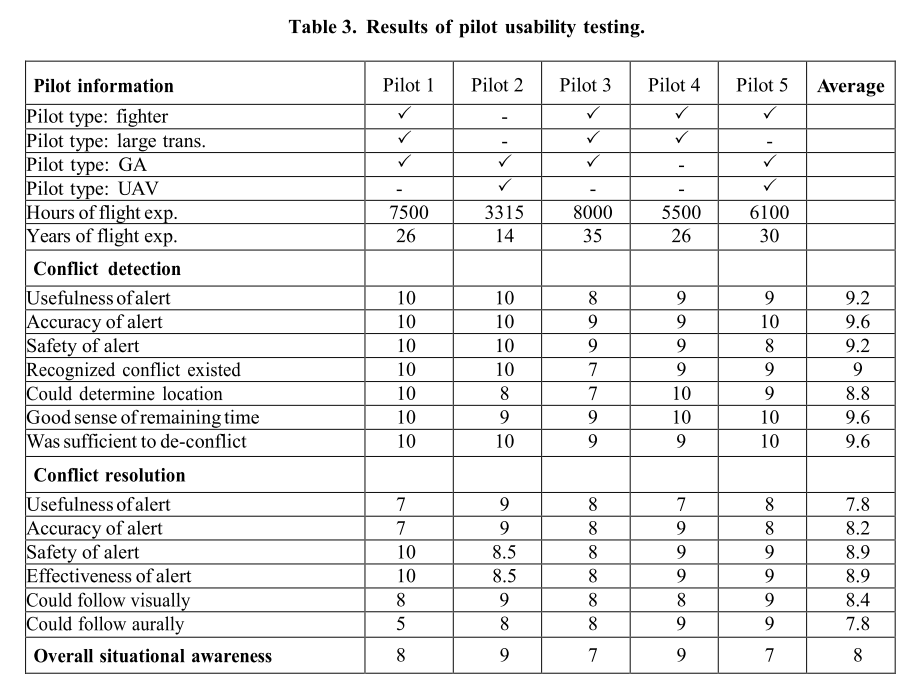
Real-Time Environment Sense and Avoid System Test with Cessna 172
On August 3, 2015, NASA conducted a “proof of concept flight of the [sense and avoid software] display system.” An instructor pilot flew a training mission in a Cessna 172 manned aircraft equipped with and recording ADS-B In surveillance data.
During this real-time flight test, the ADS-B system recorded two surveillance targets (aircrafts in range), which were detected and tracked in real-time.
This demonstration validated that the system was receiving and displaying the (a) relative horizontal position, (b) ground speed, (c) heading (directionality or track angle), (d) pressure altitude of airborne traffic relative to ownship, (e) vertical trend of airborne traffic, (f) air/ground status of aircrafts, and (g) flight ID (ICAO code).
Resources:
 Stratway Algorithm Integrated with ADS-B Sense and Avoid System
Stratway Algorithm Integrated with ADS-B Sense and Avoid System When a conflict is detected, analytical strategies are iterated. Strategy parameters are iterated until a conflict no longer exists. This process is represented below in Figure 5 above, which illustrates a conflict resolution operating on a latitude and longitude of a point. Two initial points are chosen (points A and C) with a diverted point between which is “shifted further from the original flight until the operational limits of the ownship have been reached or separation is maintained.”
When a conflict is detected, analytical strategies are iterated. Strategy parameters are iterated until a conflict no longer exists. This process is represented below in Figure 5 above, which illustrates a conflict resolution operating on a latitude and longitude of a point. Two initial points are chosen (points A and C) with a diverted point between which is “shifted further from the original flight until the operational limits of the ownship have been reached or separation is maintained.”


